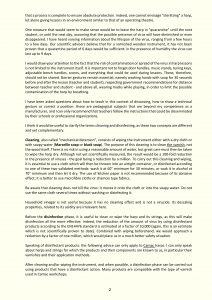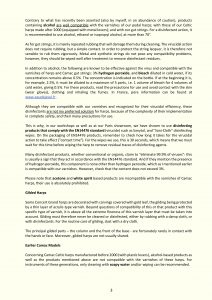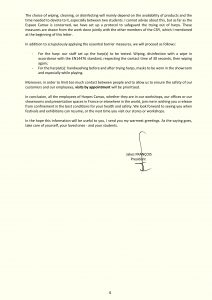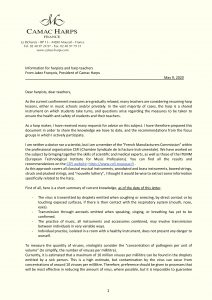Camac Blog
Harp health and safety in times of Corona: our advice to harp teachers
Latest
May 9, 2020
Information for harpists and harp teachers
From Jakez François, President of Camac Harps
May 9, 2020
As the current confinement measures are gradually relaxed, many teachers are considering resuming harp lessons, either in music schools and/or privately. In the vast majority of cases, the harp is a shared instrument on which students take turns, and questions arise regarding the measures to be taken to ensure the health and safety of students and their teachers.
As a harp maker, I have received many requests for advice on this subject. I have therefore prepared this document in order to share the knowledge we have to date, and the recommendations from the focus groups in which I actively participate.
I am neither a doctor nor a scientist, but I am a member of the “French Manufacturers Commission” within the professional organization CSFI (Chambre Syndicale de la Facture Instrumentale). We have worked on the subject by bringing together the skills of scientific and medical experts, as well as those of the ITEMM (European Technological Institute for Music Professions). You can find all the results and recommendations on the CSFI website.
As this approach covers all classical musical instruments, woodwind and brass instruments, bowed strings, struck and plucked strings, and “nouvelle luthery”, I thought it would be wise to extract some information specifically related to the harp.
First of all, here is a short summary of current knowledge, as of the date of this letter.
– The virus is transmitted by droplets emitted when coughing or sneezing, by direct contact or by touching exposed surfaces, if there is then contact with the respiratory system (mouth, nose, eyes).
– Transmission through aerosols emitted when speaking, singing, or breathing has yet to be confirmed.
– The practice of music, all instruments and accessories combined, may involve transmission between individuals in very variable ways.
– Individual practice, isolated in a room with a healthy instrument, does not present any danger to oneself.
 To measure the quantity of viruses, virologists consider the “concentration of pathogens per unit of volume” (to simplify, the number of viruses per millilitre).
To measure the quantity of viruses, virologists consider the “concentration of pathogens per unit of volume” (to simplify, the number of viruses per millilitre).
Currently, it is estimated that a maximum of 10 million viruses per millilitre can be found in the droplets emitted by a sick person. This is a high estimate, but contamination by the virus can occur from concentrations of around 10 viruses per millilitre. Therefore, preference should be given to processes that
will be most effective in reducing the amount of virus, where possible, but it is impossible to guarantee that a process is complete to ensure absolute protection. Indeed, one cannot envisage “sterilizing” a harp, let alone giving lessons in an environment similar to that of an operating theatre.
One measure that would seem to make sense would be to leave the harp in “quarantine” until the next student, or until the next day, assuming that the possible presence of virus will have diminished or even disappeared. I have heard varying information about the lifespan of the virus, ranging from a few hours to a few days. Our scientific advisers believe that for a varnished wooden instrument, it has not been proven that a quarantine period of 6 days would be sufficient: in the presence of humidity the virus can last up to 9 days.
I would draw your attention to the fact that the risk of contamination or spread of the virus in harp lessons is not limited to the instrument itself. It is important not to forget door handles, music stands, tuning keys, adjustable bench handles, scores, and everything that could be used during lessons. These, therefore, should not be shared. Barrier gestures remain essential, namely washing hands with soap for 30 seconds before and after the lesson (teacher and student), respecting government recommendations for distance between teacher and student – and above all, wearing masks while playing, in order to limit the possible contamination of the harp by breathing.
I have been asked questions about how to teach in this context of distancing, how to show a technical gesture or correct a position: these are pedagogical subjects that are beyond my competence as a manufacturer, and I can only recommend that teachers follow the instructions that could be disseminated by their schools or professional organisations.
I think it would be useful to clarify the terms cleaning and disinfecting, as these two concepts are different and yet complementary.
Cleaning, also called “mechanical detersion”, consists of wiping the instrument either with a dry cloth or with soapy water (Marseille soap or black soap). The purpose of this cleaning is to clean the varnish, not the wood itself. There is no risk in using a reasonable amount of water, but great care must then be taken to wipe the harp dry. Although not yet scientifically measured, the result would be a 100-fold reduction in the presence of viruses – the goal being a reduction by a million. To carry out this cleaning and wiping, it is essential to use a cloth which will then be thrown into an airtight container, or disinfected according to one of these two validated methods: wash it at 60° minimum for 30 minutes, or soak it in alcohol at 70° minimum and then let it dry. The use of kitchen paper is not recommended because of its abrasive effect; it is better to use microfibre cloths or chamois type fabrics.
Be aware that cleaning does not kill the virus: it moves it onto the cloth or into the soapy water. Do not use the same cloth several times without washing or disinfecting it.
Household vinegar is not useful because it has no cleaning effect and is not a virucide. Its descaling properties, related to its acidity are irrelevant here.
Before the disinfection phase, it is useful to clean or wipe the harp and its strings, as this will make disinfection all the more effective. Indeed, the reduction of the amount of virus by using disinfectant products according to the EN14476 standard is estimated at a factor of 10,000 (again, this is an estimate which is not scientifically proven to date). Combined with wiping beforehand, we would approach a reduction by a factor of one million, which would place us in a much better safety situation.
Speaking of disinfectant products: the following advice can only apply to Camac harps. I can only speak about harps and strings for which the products and their components are known to us, in particular their varnishes and their application methods.
After cleaning and/or wiping the instrument, and when possible, a disinfection phase can be carried out using products that have a disinfectant action. Many products are compatible with the type of varnish used in Camac workshops.
 Contrary to what has recently been asserted (also by myself, in an abundance of caution), products containing alcohol are well compatible with the varnishes of our pedal harps; with those of our Celtic harps made after 2000 (equipped with metal levers); and with our gut strings. For a disinfectant action, it is recommended to use alcohol, ethanol or isopropyl alcohol, at more than 70°.
Contrary to what has recently been asserted (also by myself, in an abundance of caution), products containing alcohol are well compatible with the varnishes of our pedal harps; with those of our Celtic harps made after 2000 (equipped with metal levers); and with our gut strings. For a disinfectant action, it is recommended to use alcohol, ethanol or isopropyl alcohol, at more than 70°.
As for gut strings, it is mainly repeated rubbing that will damage them during cleaning. The virucidal action does not require rubbing, but a simple contact. In order to protect the string lacquer, it is therefore not sensible to rub them vigorously. Metal and synthetic strings do not pose any compatibility problems, however, they should be wiped well after treatment to remove disinfectant residues.
In addition to alcohol, the following are known to be effective against the virus and compatible with the varnishes of harps and Camac gut strings: 3% hydrogen peroxide, and bleach diluted in cold water, if its concentration remains above 0.5%. The concentration is indicated on the bottle. If at the beginning it is, for example, 2.5%, it must be diluted to a maximum of 5 parts, i.e. 1 volume of bleach for 4 volumes of cold water, giving 0.5%. For these products, read the precautions for use and avoid contact with the skin (wear gloves), clothing and inhaling the fumes. In France, more information can be found at www.eaudejavel.fr .
Although they are compatible with our varnishes and recognized for their virucidal efficiency, these disinfectants are not my preferred solution for harps, because of the complexity of their implementation in complete safety, and their many precautions for use.
This is why, in our workshops as well as at our Paris showroom, we have chosen to use disinfecting products that comply with the EN14476 standard (virucide) such as Sanytol, and “Sani-Cloth” disinfecting wipes. On the packaging of EN14476 products, remember to check how long it takes for the virucidal action to take effect (“contact time”). For the wipes we use, this is 30 seconds, which means that we must wait for this time before wiping the harp to remove residual traces of disinfecting agents.
Many disinfectant products, whether conventional or organic, claim to “eliminate 99.9% of viruses”: this is usually a sign that they act in accordance with the EN14476 standard. And if they mention the presence of hydrogen peroxide, this component is none other than hydrogen peroxide, which as I mentioned earlier is compatible with our varnishes. However, check that the content does not exceed 3%.
Please note that acetone– and white spirit-based products are incompatible with the varnishes of Camac harps, their use is absolutely prohibited.
Some Concert Grand harps are decorated with carvings covered with gold leaf, the gilding being protected by a thin layer of acrylic-type varnish. Beyond questions of compatibility of this or that product with this specific type of varnish, it is above all the extreme fineness of this varnish layer that must be taken into account. Gilding must therefore never be cleaned or disinfected, either by rubbing with a damp cloth, or with disinfectants. For the routine care of gilding, dust with a dry cloth.
The principal gilded parts – the column and the front of the base – are fortunately rarely in contact with the hands or face. Moreover, gilded harps are not usually shared.
Concerning Camac Celtic harps manufactured before 2000 (with plastic levers), alcohol-based products as well as the products mentioned above are not compatible with the varnishes of these harps. For instruments of these generations, only cleaning with soapy water and/or wiping can be recommended.
The choice of wiping, cleaning, or disinfecting will mainly depend on the availability of products and the time needed to devote to it, especially between two students. I cannot advise about this, but as far as our Paris showroom is concerned, we have set up a protocol to safeguard the trying out of harps. These measures are drawn from the work done jointly with the other members of the CSFI, which I mentioned at the beginning of this letter.
In addition to scrupulously applying the essential barrier measures, we will proceed as follows:
– For the harp: our staff set up the harp(s) to be tested. Wiping, disinfection with a wipe in accordance with the EN14476 standard, respecting the contact time of 30 seconds, then wiping again;
– For the harpist(s): handwashing before and after trying harps, masks to be worn in the showroom and especially while playing.
Moreover, in order to limit too much contact between people and to allow us to ensure the safety of our customers and our employees, visits by appointment will be prioritised.
 In conclusion, all the employees of Camac Harps, whether they are in our workshops, our offices or our showrooms and presentation spaces in France or elsewhere in the world, join me in wishing you a release from confinement in the best conditions for your health and safety. We look forward to seeing you when festivals and exhibitions can resume, or the next time you visit our stores or workshops.
In conclusion, all the employees of Camac Harps, whether they are in our workshops, our offices or our showrooms and presentation spaces in France or elsewhere in the world, join me in wishing you a release from confinement in the best conditions for your health and safety. We look forward to seeing you when festivals and exhibitions can resume, or the next time you visit our stores or workshops.
In the hope this information will be useful to you, I send you my warmest greetings. As the saying goes, take care of yourself, your loved ones – and your students.
Jakez FRANÇOIS
President


Thanks so much for your sharing and helps a lot for a beginner like me!!!
Thank you very much for this important and detailled information!
Greetings from Vienna,
Mirjam
Many thanks Jakez,
Very helpful advice. Keep safe,
Áine Ní Dhubhghaill